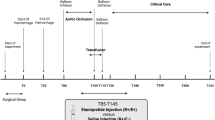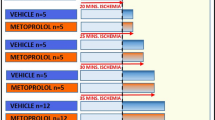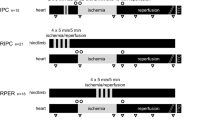Abstract
Purpose
We assessed the dose or timing effect of milrinone administered against myocardial stunning in 37 anesthetized open-chest swine.
Methods
All swine were subjected to 12-min ischemia followed by reperfusion to produce myocardial stunning. Group A (n = 12) received saline in place of milrinone both before and after ischemia. Group B (n = 9) and C (n = 9) received intravenous milrinone at a rate of 5 μg/kg/min for 10 min followed by 0.5 μg/kg/min for 10 min and 10 μg/kg/min for 10 min followed by 1 μg/kg/min for 10 min, respectively, until 30 min before coronary occlusion. Group D (n = 7) received the same dose of milrinone as group B starting 1 min after reperfusion. Myocardial contractility was assessed by percentage segment shortening (%SS).
Results
Five swine in group A and two swine in groups B and C each had ventricular fibrillation or tachycardia after reperfusion, and were thus excluded from further analysis. The percentage changes of %SS from the baseline 90 min after reperfusion in groups B, C, and D were 78 ± 9%, 82 ± 13%, and 79 ± 7%, respectively, which were significantly higher than those in group A (43 ± 13%).
Conclusion
We conclude that milrinone administered before ischemia or just after reperfusion attenuates myocardial stunning.
Similar content being viewed by others
References
Evans DB. Overview of cardiovascular physiologic and pharmacologic aspects of selective phosphodiesterase peak III inhibitors. Am J Cardiol 1989;63:9A–11A.
Colucci WS. Cardiovascular effects of milrinone. Am Heart J 1991;121:1945–7.
Metra M, Nodari S, D’Aloia A et al. Beta-blocker therapy influences the hemodynamic response to inotropic agents in patients with heart failure: a randomized comparison of dobutamine and enoximone before and after chronic treatment with metoprolol and carvedilol. J Am Coll Cardiol 2002;40:1248–58.
Levy JH, Bailey JM, Deeb GM. Intravenous milrinone in cardiac surgery. Ann Thorac Surg 2002;73:325–30.
Schwinn DA, Leone BJ, Spahn DR et al. Desensitization of myocardial beta-adrenergic receptors during cardiopulmonary bypass. Evidence for early uncoupling and late downregulation. Circulation 1991;84:2559–67.
Sanada S, Kitakaze M, Papst PJ et al. Cardioprotective effect afforded by transient exposure to phosphodiesterase III inhibitors: the role of protein kinase A and p38 mitogen-activated protein kinase. Circulation 2001;104:705–10.
Nomura Y, Horimoto H, Mieno S et al. Repetitive preischemic infusion of phosphodiesterase III inhibitor olprinone elicits cardioprotective effects in the failing heart after myocardial infarction. Mol Cell Biochem 2003;248:179–84.
Saltman AE, Gaudette GR, Levitsky S, Krukenkamp IB. Amrinone preconditioning in the isolated perfused rabbit heart. Ann Thorac Surg 2000;70:609–13.
Kim SJ, Depre C, Vatner SF. Novel mechanisms mediating stunned myocardium. Heart Fail Rev 2003;8:143–53.
Kloner RA, Jennings RB. Consequences of brief ischemia: stunning, preconditioning, and their clinical implications: part 1. Circulation 2001;104:2981–9.
Grubitzsch H, Ansorge K, Wollert HG, Eckel L. Stunned myocardium after off-pump coronary artery bypass grafting. Ann Thorac Surg 2001;71:352–5.
Ruiz-Bailen M, Aguayo de Hoyos E, Ruiz-Navarro S et al. Reversible myocardial dysfunction after cardiopulmonary resuscitation. Resuscitation 2005;66:175–81.
Kloner RA, Bolli R, Marban E, Reinlib L, Braunwald E. Medical and cellular implication of stunning, hibernation, and preconditioning; an NHLBI work shop. Circulation 1998;97:1848–67.
Vinten-Johansen J, Zhao ZQ, Zatta AJ, Kin H, Halkos ME, Kerendi F. Postconditioning—a new link in nature’s armor against myocardial ischemia–reperfusion injury. Basic Res Cardiol 2005;100:295–310.
Halkos ME, Kerendi F, Corvera JS et al. Myocardial protection with postconditioning is not enhanced by ischemic preconditioning. Ann Thorac Surg 2004;78:961–9.
Zhao ZQ, Corvera JS, Wang N-P et al. Inhibition of myocardial injury by ischemic postconditioning during reperfusion: comparison with ischemic preconditioning. Am J Physiol Heart Circ Physiol 2003;285:H579–88.
Jonassen AK, Sack MN, Mjos OD, Yellon DM. Myocardial protection by insulin at reperfusion requires early administration and is mediated via Akt and p70s6 kinase cell-survival signaling. Circ Res 2001;89:1191–8.
Bell RM, Yellon DM. Atorvastatin, administered at the onset of reperfusion, and independent of lipid lowering, protects the myocardium by up-regulating a pro-survival pathway. J Am Coll Cardiol 2003;41:508–15.
Toller WG, Kersten JR, Pagel PS, Hettrick DA, Warltier DC. Sevoflurane reduces myocardial infarct size and decreases the time threshold for ischemic preconditioning. Anesthesiology 1999;91:1437–46.
Peart JN, Gross ER, Gross GJ. Opioid-induced preconditioning: recent advances and future perspectives. Vascul Pharmacol 2005;42:211–8.
Weihrauch D, Krolikowski JG, Bienengraeber M, Kersten JR, Warltier DC, Pagel PS. Morphine enhances isoflurane-induced postconditioning against myocardial infarction: the role of phosphatidylinositol-3-kinase and opioid receptors in rabbits. Anesth Analg 2005;101:942–9.
Piper HM, Abdallah Y, Schafer C. The first minutes of reperfusion: a window of opportunity for cardioprotection. Cardiovasc Res 2004;61:365–71.
Bolli R, Marban E. Molecular and cellular mechanisms of myocardial stunning. Physiol Rev 1999;79:609–34.
Kikura M, Sato S. The efficacy of preemptive milrinone or amrinone therapy in patients undergoing coronary artery bypass grafting. Anesth Analg 2002;94:22–30.
Lobato EB, Florete O Jr, Bingham HL. A single dose of milrinone facilitates separation from cardiopulmonary bypass in patients with pre-existing left ventricular dysfunction. Br J Anaesth 1998;81:782–4.
Hamada Y, Kawachi K, Yamamoto T et al. Effects of single administration of phosphodiesterase III inhibitor during cardiopulmonary bypass: comparison of milrinone and amrinone. Jpn Circ J 1999;63:605–9.
Schad H, Heimisch W, Eising GP, Mendler N. Effect of milrinone and atrial pacing on stunned myocardium. Eur J Cardiothorac Surg 1997;6:1125–32.
Vandeplassche GM, Hermans CF, de Chaffoy de Courcelles DR, D’Aubioul JA, Wouters LJ, De Clerck FF. Comparative effects of R 80122, enoximone, and milrinone on left ventricular phosphodiesterase isoenzymes in vitro and on contractility of normal and stunned myocardium in vivo in dogs. J Cardiovasc Pharmacol 1992;19:714–22.
Alousi AA, Iwan T, Edelson J, Biddlecome C. Correlation of the hemodynamic and pharmacokinetic profile of intravenous milrinone in the anesthetized dog. Arch Int Pharmacodyn Ther 1984;267:59–66.
Kikura M, Levy JH, Michelsen LG et al. The effect of milrinone on hemodynamics and left ventricular function after emergence from cardiopulmonary bypass. Anesth Analg 1997;85:16–22.
Rump AF, Acar D, Klaus W. A quantitative comparison of functional and anti-ischaemic effects of the phosphodiesterase-inhibitors, amrinone, milrinone and levosimendan in rabbit isolated hearts. Br J Pharmacol 1994;112:757–62.
Rump AF, Schussler M, Acar D et al. Effects of different inotropes with antioxidant properties on acute regional myocardial ischemia in isolated rabbit hearts. Gen Pharmacol 1995;26:603–11.
Ytrehus K. The ischemic heart-experimental models. Pharmacol Res 2000;42:193–203.
Stump GL, Wallace AA, Gilberto DB, Gehret JR, Lynch JJ Jr. Arrhythmogenic potential of positive inotropic agents. Basic Res Cardiol 2000;95:186–98.
Hanich RF, Levine JH, Prood C et al. Electrophysiologic recovery in postischemic, stunned myocardium despite persistent systolic dysfunction. Am Heart J 1993;125:23–32.
Stevens RM, Jahania MS, Mentzer RM, Lasley RD. Sodium-hydrogen exchange inhibition attenuates in vivo porcine myocardial stunning. Ann Thorac Surg 2004;77:651–7.
Author information
Authors and Affiliations
Corresponding author
Rights and permissions
About this article
Cite this article
Use, T., Makita, T., Ureshino, H. et al. Milrinone Administered Before Ischemia or Just After Reperfusion, Attenuates Myocardial Stunning in Anesthetized Swine. Cardiovasc Drugs Ther 20, 327–334 (2006). https://doi.org/10.1007/s10557-006-0166-7
Published:
Issue Date:
DOI: https://doi.org/10.1007/s10557-006-0166-7




